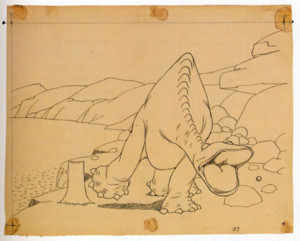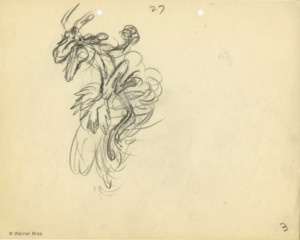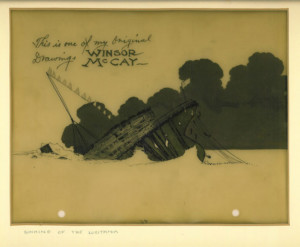Evolution of a Peg
Evolution of the Acme Peg Registration System.
by Tom Arndt
Cartoon animation requires a way to keep the separate drawings aligned or ‘registered’ throughout the production process. When I built my first animation stand at age 12, the obvious registration system was a 3-hole paper punch. The holes were suitably spaced for good stability, and a peg bar was easy to make from dowels. But while using this homemade system I discovered an important issue. Unless I carefully lifted the drawings straight up off the pegs, the parallel dowels would tear the holes in the paper. I learned to be extremely careful.
In college, I was introduced to the Acme Peg system. It held my drawings in consistent alignment, yet allowed quick and easy exchange of the drawings. I sensed a quantum shift in the speed I could animate using the Acme system.
The Acme system of metal pegs, equally spaced at 4“ center to center, alternating flat, round, flat, matches holes in the animation paper. The middle round peg (or pin) is 1/4“ diameter. The flat pegs are 1/8“ thick by about ½” long. The pegs are. The slots for the flat pegs are longer than the peg’s length. The extra space at either end of the slot allows the paper to be lifted easily without tearing the holes. This stress relief design also allows for shrinkage or expansion of the paper due to heat and humidity.
In the US there have been at least 3 other similar peg systems in use, each with different dimensions. The design for the Acme system evolved in Hollywood and different studios adopted the system at different times. Since it a record of exactly when the Acme system was first manufactured we must examine historical evidence.
A 2-hole paper punch was patented in Germany in 1886, and commercial punches were available by 1888. As animation became popular, 2 round punched holes became the primary tactic for registering the drawings, although it wasn’t the only tactic.
 For Little Nemo, 1911, Winsor McCay used cross marks to visually align his animation drawings on translucent rice paper. He used the same system for Gertie the Trained Dinosaur in 1914.
For Little Nemo, 1911, Winsor McCay used cross marks to visually align his animation drawings on translucent rice paper. He used the same system for Gertie the Trained Dinosaur in 1914.
In patent # 1,107,193,- 1914, Randolph Bray registered an idea of animating on pages with pre-printed backgrounds and cross marks to align the drawings; thus claiming the registration system used earlier by Winsor McCay.
Earl Hurd in 1917 patented the use of transparent cellulose sheets bound as a bundle for registration. He proposed animating directly on the bound cels, much like making a flip-book in the corner of your history book; patent # 1,143,542.
Bray and Hurd formed a partnership and joined their patents to create a monopoly on the technological processes. Bray made an income selling licenses for the use of the patented techniques until the patents expired in 1932.
In 1918 C F Lederer patented a way to combine cels with the background using a form of double exposure-matte process; patent # 1,375,918. His patent drawings included the 2-round-hole peg system overlooked by Bray/Hurd.
When Winsor McCay made his Sinking Of The Lusitania in 1918 he used 10 field drawings with bottom pegged, 2 holes punched on 5 1/2 “ centers.
After M J Winkler took Oswald the Lucky Rabbit from Walt Disney in 1928, Carl Laemmle, Universal Pictures, which distributed the shorts took Oswald from Winkler and hired Walter Lantz to produce them. All examples of the early Walter Lantz Oswalds were done on 2 hole, bottom pegs with 4” centers. This peg system seems to be the norm for West coast studios.
Walt Disney’s first Mickey Mouse film, Plane Crazy – 1928 was on 12 field bottom pegged paper, with 2 holes on 4“ centers.
In 1928, Adolph Furer founded a contract machine shop in Hollywood CA, calling it Acme Tool and Manufacturing Company. Walt and Roy Disney contracted him to modify a Bell & Howell motion picture camera for stop motion.
In 1929 F L Goldman secured a patent for animation technology that included a 3-round hole peg system, with replacement cellulose ‘cels’ as a technique for producing animated films; patent # 1,715,127. Although Bray-Hurd have the distinction of launching the use of cels, Goldman’s patent describes the practical industry use of the cels.
An important detail in Goldman’s peg design was the presence of stress relief gaps in the punched holes on either side of the outer 2 pegs. Around 1945 this patent passed into public domain.
 In 1930 when Disney asked Furer to modify additional cameras, Furer decided Acme should begin manufacturing an original camera design. This Acme Camera was the beginning of a product line supplying the animation and film industry. Eventually Acme was manufacturing equipment used by Disney, Warner Brothers and Hanna Barbera at MGM.
In 1930 when Disney asked Furer to modify additional cameras, Furer decided Acme should begin manufacturing an original camera design. This Acme Camera was the beginning of a product line supplying the animation and film industry. Eventually Acme was manufacturing equipment used by Disney, Warner Brothers and Hanna Barbera at MGM.
In 1933 Walter Lantz produced an Oswald film, titled Candy House, drawn on 12 field paper bottom pegged, with 2 holes. These drawings, however, are punched with the right hole wider than the left, with pegs on 5“ centers. (Example in SF Cartoon Art Museum Collection)
Some drawings from the collection of an ex-inker/painter at the Jam Handy Organization in Detroit Michigan were punched with 2-hole, top pegs, with the right hole wider than the left. These drawings are undated, but probably date from 1945, or earlier.
These two examples are the only drawings I have found where the industry used the Goldman stress relief design on standard 2 hole registration.
 Page 42 shows a background for Mickey’s Fire Brigade – 1935. Here we see 5-holes punched in a row. This is a combination of the earlier 2-hole system and a new style, 3 hole system unique to the Disney studio. This, five hole, transitional arrangement was used while the pegs on the disks, and camera stands throughout the studio were updated to the new Disney 3-hole system.
Page 42 shows a background for Mickey’s Fire Brigade – 1935. Here we see 5-holes punched in a row. This is a combination of the earlier 2-hole system and a new style, 3 hole system unique to the Disney studio. This, five hole, transitional arrangement was used while the pegs on the disks, and camera stands throughout the studio were updated to the new Disney 3-hole system.
There probably never was a 5 hole punch. They would have simply punched the additionalthree holes into existing 2 hole paper and cels during the transition period.
The dimensions of the Disney pegs are the same as the later Acme pegs, but with different spacing. The Disney arrangement put the flat pegs centered at 3 1/2“ to either side of the pin, rather than the 4“ center of the Acme pegs.
From the relationship between Acme and Disney, it seems likely that the Disney designers worked with Acme to design and manufacture the new ‘high tech’ pegs incorporating the advantage of the wider peg slot. The artists were accustomed to the tearing problem while using the 2 hole pegs; and by now they should have been aware of the Goldman patent design, or the stress relief 2 hole punch design used by some studios.
An example on page 298 in Thomas and Johnston’s The Illusion of Life, shows a long layout drawing for The Old Mill- 1937, which is punched with just the 3 peg Disney arrangement. The Old Mill preceded Pinocchio, so we can assume Pinocchio was animated entirely on the new 3 peg system. Paper and cels would have been punched in large volume to supply the studio needs. They would have continued using cels with 5 holes until they used them up.
Once Disney had introduced their new system, any animator migrating to another studio could share the concept with the industry. The question remains, when did Acme begin manufacturing and marketing their system?
If Acme was waiting for the Goldman patent to expire, then perhaps they rolled out their own design around 1945, for mass distribution. That hypothesis seems to fit with the evidence.
Warner Brother’s released The Hair Brained Hypnotist- in 1942, on 12 field paper, top peg, 2-holes, without any oval strain relief holes.
 Uncle Tom’s Cabana, directed by Tex Avery At MGM – 1947 was on Acme registration.
Uncle Tom’s Cabana, directed by Tex Avery At MGM – 1947 was on Acme registration.
Although the name Acme appears in the first Road Runner cartoon, Fast and Furry-ous – 1949, it must be assumed that ‘Acme’ referred to the camera equipment from Acme. There is no indication Warner’s was using Acme Pegs at the time. At the end of the Duck Amuck, 1953, we see Bugs Bunny drawing at a disk with two holes, top pegged.
By 1952 Acme had stopped manufacturing animation equipment to focus on specialty cameras only. Other manufactures apparently picked up the mantle and marketed acme style pegs. Despite small variations in the flat peg and slots, they are all compatible with any acme punched paper.
There are a number of concept art drawings from Warner Brothers, done by Eyvid Earle on Acme punched paper around the mid-50’s. It appears Warner’s was transitioning to Acme style pegs, but on a simpler scale than at Disney
When MGM decided to close their cartoon department in 1957, animation directors William Hanna and Joseph Barbera formed H-B Enterprises, Inc in partnership with Columbia Pictures’ Screen Gems television division, to produce animation for TV. They began their new studio using Acme Registration.
By the time of The Rescuers- 1977, Disney had switched to the standard Acme registration. Perhaps their original punch had begun to show wear. By that time there was a proliferation of smaller studios in Hollywood, and a thriving market for animation supplies. By then there were off-the-shelf cel punches, and Disney again changed their registration to use the established Acme system.
As Hollywood began out-sourcing animation overseas in the ‘70s, they exported the Acme system to register their drawings. The result is that most traditional animation studios around the world now use the Acme System.
Over the years that I’ve worked with the Acme pegs, the one dimension, which the punch manufactures have not agreed upon, is the spacing from the edge of the paper to the center line of the pegs. This variation shows up as an issue in smaller shops which may buy from different suppliers.
When this spacing is not consistent it makes precise ‘off-the-peg’ in-betweening difficult, since we refer to the location of the corners while aligning the new drawing.
The industry has settled on the dimension for 12 field paper as 12.5“ x10.5“. I propose establishing a standard dimension of 3/8“ from peg center line to the paper edge. Many manufactures use this dimension, but others use 1/2“. The 3/8” spacing would add a tiny amount of drawing area, and would be easy to retro fit any existing cel punch. We merely add a narrow spacer bar at the back of the cel punch.
In the digital age we still use Acme registration. Many of us older animators still prefer the flexibility of animating using pegged paper. When we scan the drawings most high-end ink and paint systems use the peg-hole images to align the scans.
Paperless animation is popular but the Acme pegs are still alive.



